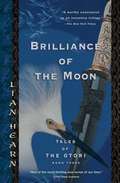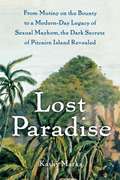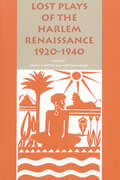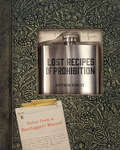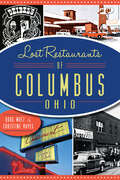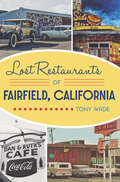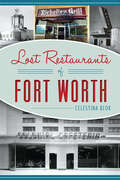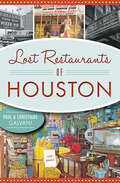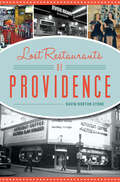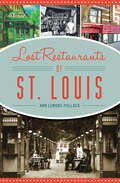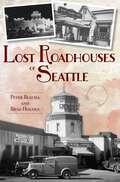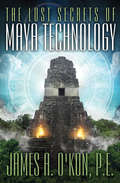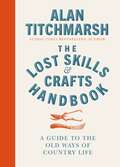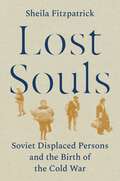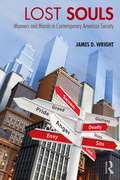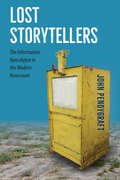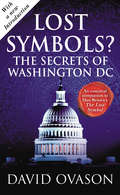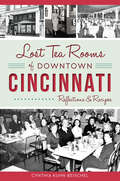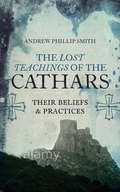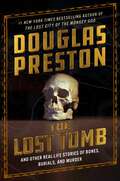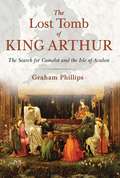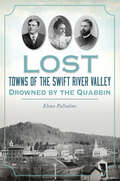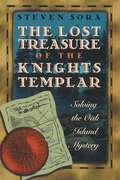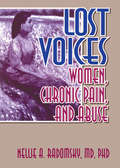- Table View
- List View
The Lost of Art of Walking
by Geoff NicholsonHow we walk, where we walk, why we walk tells the world who and what we are. Whether it's once a day to the car, or for long weekend hikes, or as competition, or as art, walking is a profoundly universal aspect of what makes us humans, social creatures, and engaged with the world. Cultural commentator, Whitbread Prize winner, and author of Sex Collectors Geoff Nicholson offers his fascinating, definitive, and personal ruminations on the literature, science, philosophy, art, and history of walking. Nicholson finds people who walk only at night, or naked, or in the shape of a cross or a circle, or for thousands of miles at a time, in costume, for causes, or for no reason whatsoever. He examines the history and traditions of walking and its role as inspiration to artists, musicians, and writers like Bob Dylan, Charles Dickens, and Buster Keaton. In The Lost Art of Walking, he brings curiosity, imagination, and genuine insight to a subject that often strides, shuffles, struts, or lopes right by us. .
Lost Paradise: From Mutiny on the Bounty to a Modern-day Legacy of Sexual Mayhem, the Dark Secrets of Pitcairn Island Revealed
by Kathy MarksPitcairn Island -- remote and wild in the South Pacific, a place of towering cliffs and lashing surf -- is home to descendants of Fletcher Christian and the Mutiny on the Bounty crew, who fled there with a group of Tahitian maidens after deposing their captain, William Bligh, and seizing his ship in 1789. Shrouded in myth, the island was idealized by outsiders, who considered it a tropical Shangri-La. But as the world was to discover two centuries after the mutiny, it was also a place of sinister secrets. In this riveting account, Kathy Marks tells the disturbing saga and asks profound questions about human behavior. In 2000, police descended on the British territory -- a lump of volcanic rock hundreds of miles from the nearest inhabited land -- to investigate an allegation of rape of a fifteen-year-old girl. They found themselves speaking to dozens of women and uncovering a trail of child abuse dating back at least three generations. Scarcely a Pitcairn man was untainted by the allegations, it seemed, and barely a girl growing up on the island, home to just forty-seven people, had escaped. Yet most islanders, including the victims' mothers, feigned ignorance or claimed it was South Pacific "culture" -- the Pitcairn "way of life." The ensuing trials would tear the close-knit, interrelated community apart, for every family contained an offender or a victim -- often both. The very future of the island, dependent on its men and their prowess in the longboats, appeared at risk. The islanders were resentful toward British authorities, whom they regarded as colonialists, and the newly arrived newspeople, who asked nettlesome questions and whose daily dispatches were closely scrutinized on the Internet. The court case commanded worldwide attention. And as a succession of men passed through Pitcairn's makeshift courtroom, disturbing questions surfaced. How had the abuse remained hidden so long? Was it inevitable in such a place? Was Pitcairn a real-life Lord of the Flies? One of only six journalists to cover the trials, Marks lived on Pitcairn for six weeks, with the accused men as her neighbors. She depicts, vividly, the attractions and everyday difficulties of living on a remote tropical island. Moreover, outside court, she had daily encounters with the islanders, not all of them civil, and observed firsthand how the tiny, claustrophobic community ticked: the gossip, the feuding, the claustrophobic intimacy -- and the power dynamics that had allowed the abuse to flourish. Marks followed the legal and human saga through to its recent conclusion. She uncovers a society gone badly astray, leaving lives shattered and codes broken: a paradise truly lost.
Lost Plays of the Harlem Renaissance, 1920-1940
by Leo Hamalian James V. HatchA valuable contribution to African American literary and theatrical scholarship, this volume is a compilation of sixteen plays written during the Harlem Renaissance, brought together for the first time and set in a historical context.
Lost Recipes of Prohibition: Rediscovered Formulas And Forgotten Recipes For Liquors, Cordials, And Wines From The Secret Notebook Of A Prohibition-era Doctor
by Matthew RowleyNearly everyone has heard of bathtub gin, but how many people know what it really was--or how to make it? During the height of the Prohibition, one anonymous physician compiled more than 200 recipes for "compounding" spirits, hiding the manuscript from authorities. By adding extracts, essences, and oils to plain old sugar moonshine, bootleggers would simulate the taste of gin, whiskey, cordials, rums, absinthes. . . booze that was otherwise impossible to procure. The potential profits were staggering. This document fell into the hands of author Matthew Rowley, who became fascinated with the process of compounding and the historical events that lead to this mysterious and lucrative manuscript. In addition to annotating the actual pages of the book, Rowley provides a historical background, and gives his readers an overview of the process, updating some of the recipes for modern distillers, bartenders, and cocktail enthusiasts.
Lost Restaurants of Columbis, Ohio (Lost Ser.)
by Doug Motz Christine HayesDig into the storied restaurant history of the Buckeye State&’s capital city. Ohio&’s capital city has long had a vibrant restaurant culture that included German immigrants, High Street eateries and the fads of the times. Gertrude Stein and Alice B. Toklas wrote their thanks for a great meal at the Maramor. Yankees star Tommy Henrich held his customers spellbound with stories in his Diamond Room. Mama Marzetti dropped William Oxley Thompson&’s birthday cake and swept it back up off the floor. Join authors Doug Motz and Christine Hayes as they explore the stories of Woody Hayes&’s Jai Lai, manhole cover menus and bathtub décor at Water Works, as well as many other lost and beloved restaurants.
Lost Restaurants of Fairfield, California (American Palate)
by Tony WadeDelve into the memories, meals, and the men and women behind Fairfield's' beloved former dining spots.Since the city's incorporation in 1903, Fairfield's restaurants have reflected the simple tastes of suburban life, serving up good food and great times at places like the Firehouse Deli-Café, the Hi-Fi Drive-In and beyond. Longtime residents knew the best Mexican food north of Tijuana could be found at Dan & Ruth's Café, and Voici, where the movers and shakers met, claimed the crown as swankiest spot in town. Smorga Bob's, the buffet-style family restaurant where locals could let their hair down and get their grub on, is missed to this day.Join longtime Daily Republic columnist and accidental local historian Tony Wade on a delicious tour of bygone eateries.
Lost Restaurants of Forth Worth (American Palate)
by Celestina BlokDespite a thriving culinary scene, Fort Worth lost some of its most iconic restaurants decades ago. Locals still buzz about the legendary chili dished out at historic Richelieu Grill and the potato soup Sammy's served all night. Fort Worth could accommodate every palate, from the Bakon Burger at Carlson's Drive-Inn to the escargot and chateaubriand laid out at the Carriage House. Even movie stars like Bob Hope and Gene Autry frequented the city for steaks from the Seibold Café, and President Lyndon B. Johnson loved Cowtown for the barbecue from famed chuckwagon cook Walter Jetton. Join food writer Celestina Blok as she journeys through her hometown's dining past.
Lost Restaurants of Houston (American Palate)
by Paul Galvani Christiane Galvani&“Stories of immigration, culture-clash . . . and old-fashioned hard work are told through the history of Houston&’s long-gone, but still-beloved restaurants.&” —Yesterday&’s America With more than fourteen thousand eating establishments covering seventy different ethnic cuisines, Houston is a foodie town. But even in a place where eating out is a way of life and restaurants come and go, there were some iconic spots that earned a special place in the hearts and stomachs of locals. Maxim&’s taught overnight millionaires how to handle meals that came with three forks. The Trader Vic&’s at the Shamrock offered dedicated homebodies a chance for the exotic, and Sonny Look&’s Sirloin Inn maintained the reputation of a city of steakhouses. From Alfred&’s Delicatessen to Youngblood&’s Fried Chicken, Paul and Christiane Galvani celebrate the stories and recipes of Houston&’s fondly remembered tastemakers. &“In the book, the Galvanis share Houston&’s history and love of food. They take the reader on the banks of the bayou when the city received its first inhabitants before time hopping from the Original Mexican Restaurant to The Original Kelley&’s Steakhouse. Other stops include Alfred&’s Delicatessen and the San Jacinto Inn.&” —Houston Business Journal
Lost Restaurants of Providence (American Palate)
by David Norton StoneA culinary history of Providence and the memorable eateries that once made their homes there. In the city that invented the diner, so many amazing restaurants remain only in memories. The Silver Top had fresh coffee every twenty minutes, and the Ever Ready was hot dog heaven. Miss Dutton's Green Room and the Shepard Tea Room beckoned shoppers in their Sunday finest. At Childs, the griddle chef made butter cakes in the window for night owls, and Harry Houdini supped at midnight with H.P. Lovecraft at the Waldorf Lunch. Themed lounges like the Beachcomber and the Bacchante Room chased away the Prohibition blues. Downcity Diner offered a famous meatloaf, and Ming Garden&’s Ming Wings were a staple for regulars. Author David Norton Stone details the restaurants that still hold a place in the hearts of locals
Lost Restaurants of St. Louis (American Palate Ser.)
by Ann Lemons PollackA culinary history of the Gateway City and the memorable restaurants that once made their home there.St. Louis is a food town, and there are many restaurants that have captured the heart of the city. Some of them are no longer around. Rossino&’s low ceilings and even lower pipes didn&’t stop the pizza-hungry residents from crowding in. Jefferson Avenue Boarding House served elegant &“Granny Food&” in plush surroundings. King Burgers and onion rings ruled at the Parkmoor. Dohack&’s claimed it was the first to name the &“jack salmon.&” Author Ann Lemons Pollack details these and more restaurants lost to time in the Gateway City.&“Few St. Louisans know the history of the St. Louis food scene like local food and travel writer Ann Lemons Pollack. . . . The book is a treasure trove for St. Louis history-lovers, beginning with an extensively researched look at the food served at the 1904 Louisiana Purchase Exposition—better known as the 1904 World&’s Fair—hosted in St. Louis. She debunks some myths—hot dogs were not &“invented&” at the fair, but perhaps found a wide audience there—and charts the various restaurants and cafes that fed eager fairgoers.&”—Feast Magazine
Lost Roadhouses of Seattle (American Palate)
by Peter Blecha Brad HoldenProhibition came early to Washington State--in 1916--and kicked off an unforgettable era of nightlife.Prohibition went national in 1920 and a network of roadside inns, taverns and dancehalls just outside of Seattle's city limits thrived well into the rockin' 1950s, providing illicit entertainment for those seeking a good time. Spurred on by early car culture and strict liquor laws, places like the Spanish Castle, The Jungle and The Black Cat sprang into being. Commonly called roadhouses, many of these remote outposts existed along two newly-built and parallel stretches of county highways - far from the prying eyes of city police. Fabled speakeasy operator, "Doc" Hamilton founded some of the earliest of these hideaways.Join authors Peter Blecha and Brad Holden as they uncover the fascinating era of forbidden nightclubs.
The Lost Secrets of Maya Technology
by James A. O'KonThe pioneering archaeo-engineer uncovers the advanced technologies of the Maya—from ancient highways to the concept of zero. The mysteries of the Maya have been a source of fascination since the ancient civilization was discovered in the 19th century. Far more advanced than any civilization in Europe, Maya developed an elegant mathematic system, an incredibly accurate astronomy, and one of the world&’s first written languages. The lost principles of Maya technology allowed ancient engineers to construct grand cities that towered above the rainforest, water systems with underground reservoirs, miles of all-weather paved roads tracking through the jungle, and the longest bridge in the ancient world. Pioneering archeologist and engineer James O&’Kon combined research, field exploration, forensic engineering, and 3-D virtual reconstruction to discover the secrets of Maya technology. Here, O&’Kon recounts how Maya engineers developed structural mechanics for multi-story buildings that were not exceeded in height until the first &“skyscraper&” built in Chicago in 1885; invented the blast furnace 2,000 years before it was patented in England; and developed the vulcanization of rubber more than 2,600 years before Charles Goodyear.
Lost Skills and Crafts Handbook
by Alan TitchmarshIn this inspirational and practical guide to country life, passionate and hugely knowledgeable countryman Alan Titchmarsh explores the heritage of rural Britain, its landscapes and wildlife, its traditions, customs and crafts. The Lost Skills and Crafts Handbook will help you rediscover your love of the countryside, including:- a checklist of British butterflies and where to find them- how to keep chickens, ducks, goats and sheep- how to make soap, candles and your own herbal remedies- how to track animals and forage for food- essential knot tying- how to build a campfire without matches- how to create a kitchen garden- the origins of country superstitionsAnd much more. With beautiful line art illustrations throughout, this compendium of the British countryside and its delights will be an essential read for any nature lover in your life.
Lost Souls: Soviet Displaced Persons and the Birth of the Cold War
by Sheila FitzpatrickA vivid history of how Cold War politics helped solve one of the twentieth century&’s biggest refugee crisesWhen World War II ended, about one million people whom the Soviet Union claimed as its citizens were outside the borders of the USSR, mostly in the Western-occupied zones of Germany and Austria. These &“displaced persons,&” or DPs—Russians, prewar Soviet citizens, and people from West Ukraine and the Baltic states forcibly incorporated into the Soviet Union in 1939—refused to repatriate to the Soviet Union despite its demands. Thus began one of the first big conflicts of the Cold War. In Lost Souls, Sheila Fitzpatrick draws on new archival research, including Soviet interviews with hundreds of DPs, to offer a vivid account of this crisis, from the competitive maneuverings of politicians and diplomats to the everyday lives of DPs.American enthusiasm for funding the refugee organizations taking care of DPs quickly waned after the war. It was only after DPs were redefined—from &“victims of war and Nazism&” to &“victims of Communism&”—in 1947 that a solution was found: the United States would pay for the mass resettlement of DPs in America, Australia, and other countries outside Europe. The Soviet Union protested this &“theft&” of its citizens. But it was a coup for the United States. The choice of DPs to live a free life in the West, and the West&’s welcome of them, became an important theme in America&’s Cold War propaganda battle with the Soviet Union.A compelling story of the early Cold War, Lost Souls is also a rare chronicle of a refugee crisis that was solved.
Lost Souls: Manners and Morals in Contemporary American Society
by James D. WrightWhat is the state of contemporary American morality? From their original conception in Christian scripture to their assimilation into Western culture, the 'Seven Deadly Sins' – lust, greed, envy, pride, and all the rest – have guided human morality, steering human behavior and psychology away from evil and toward a full embrace of the good. But their hold on modern life is increasingly tenuous. Indeed, one may observe that these days, deadly sin is far more common and more commonly practiced than its virtuous counterparts – humility, charity, kindness, industriousness, and chastity. Without greed, there is no economy; without anger, no politics; and without pride and envy, surely less motivation and competition would exist. James D. Wright carefully examines the complexities and ambiguities in modern society in the context of the seven deadly sins and their corresponding virtues. Are we all lost souls, condemned by our immoral deeds, or are the trappings of older sin deteriorating? Is it time, finally, to reconsider the classifications of evil and good? Wright uses each chapter to consider how the social sciences have operationalized each 'sin', how they have been studied, and what lessons have been learned over time. He reviews recent trends and contemplates the societal costs and benefits of the behaviors in question. Lost Souls emerges, then, as a meditation on contemporary sin, concluding that the line between guilt and innocence, right and wrong, is often very thin.
Lost Storytellers: The Information Apocalypse in the Modern Newsroom
by John PendygraftCommunity journalism in the era of clickbait An incisive and firsthand look at the landscape of community news today, Lost Storytellers argues that the decline of local journalism threatens the future of democracy. Award-winning photojournalist John Pendygraft asks: How did Americans lose trust in the media, and how can their local newsrooms earn it back? Pendygraft uses his own experiences at Florida’s largest newspaper, the Tampa Bay Times, to illustrate why trusted local reporting matters more than ever in the era of “fake news,” clickbait, conspiracy theories, and social media. Through interviews with his colleagues, the history of his own paper, journeys into the evolutionary psychology of storytelling, and examples of the ways multinational media conglomerates hook readers on news cycles of chaos and crisis, Pendygraft argues that community journalists can reclaim their roles as local storytellers—and that the public good demands that they try. Lost Storytellers offers insights for all who feel confused about the media, politics, and the well-being of their communities in the information age.
Lost Symbols?: The Secrets of Washington DC
by David OvasonThe secrets, the myths and the facts behind Washington, D.C.'s design and its Masonic significance.In this groundbreaking, original work, David Ovason reveals the intimate connections between the mysterious zodiacal symbols and the stellar lore of Washington, D.C. and the secret plan for the city.There are over fifty complete zodiacs in Washington, D.C., all witness to an extraordinary stellar mystery. Why did generations of architects and artists put their lives and energies on the line, when designing this City of the Stars? What was their shared secret language? What or who drove them to create a city overflowing with such esoteric symbolism? What is the meaning behind the secret symbolism of Washington, D.C.'s layout? And what does it mean for America's future?
Lost Tea Rooms of Downtown Cincinnati: Reflections & Recipes (American Palate)
by Cynthia Kuhn BeischelIt was a different time. Ladies wore gloves, hats and nice attire to luncheons at the Woman's Exchange. Shillito's provided a cosmopolitan environment for its patrons, while Mullane's was the perfect place to sip and socialize. The popular Good Morning Show radio program hosted by charming Bob Braun, and later Nick Clooney, was broadcast from McAlpin's Tea Room. Women gathered at Pogue's and Mabley & Carew tea rooms to celebrate birthdays, as well as wedding and baby showers, over dainty tea sandwiches. Author Cynthia Kuhn Beischel brings the Queen City's bygone downtown tea rooms back to life and shares more than one hundred beloved recipes.
Lost Teachings of the Cathars
by Andrew Phillip SmithCenturies after the brutal slaughter of the Cathars by papally endorsed Northern French forces,and their suppression by the Inquisiton the medieval Cathars continue to exert a powerful influence on both popular culture and spiritual seekers. Yet few people know anything of the beliefs of the Cathars beyond vague notions that they believed in reincarnation, were vegetarians, were somehow Gnostic, and had some relation to Mary Magdalene. The Lost Teachings of the Cathars explores the history of this Christian dualist movement between the 12th and 14th centuries, offering a sympathetic yet critical examination of its beliefs and practices. As well as investigating the origin of the Cathars, their relationship to the ancient Gnostics of the early centuries AD and the possibility that they survived the Inquisition in some way, the author also addresses recent renewed interest in Catharism. Eccentric esotericists initiated a neo-Cathar revival in the Languedoc which inspired the philosopher Simone Weil. The German Otto Rahn, who has been called the real-life Indiana Jones, believed that the Cathars were protectors of the Holy Grail and received support from Heinrich Himmler. Arthur Guirdham, a psychiatrist from the West of England, became convinced that he and a circle of patients had all been Cathars in previous lives. Tourists flock to the Languedoc to visit Cathar country. Bestsellers such as Kate Mosse's timeslip novel Labyrinth continue to fascinate readers. But what did the Cathars really believe and practice? From the Trade Paperback edition.
The Lost Tomb: And Other Real-Life Stories of Bones, Burials, and Murder
by Douglas PrestonFrom the #1 bestselling author of The Lost City of the Monkey God, a jaw-dropping discovery of an Egyptian tomb opens up a slew of archaeological mysteries and deadly tales. Now in paperback with an EXCITING BONUS ADVENTURE! What&’s it like to be the first to enter an Egyptian burial chamber that&’s been sealed for thousands of years? What horrifying secret was found among the prehistoric ruins of the American Southwest? Who really was the infamous the Monster of Florence? From the jungles of Honduras to macabre archaeological sites in the American Southwest, Douglas Preston's explorations have taken him across the globe. The Lost Tomb brings together a compelling collection of true stories about buried treasure, enigmatic murders, lost tombs, bizarre crimes, and other fascinating tales of the past and present.
The Lost Tomb of King Arthur: The Search for Camelot and the Isle of Avalon
by Graham PhillipsOne man’s journey to uncover the final resting place of the historical King Arthur • Pinpoints the exact locations of Arthur’s tomb, the ruins of Camelot, and the sword Excalibur using literary research and the latest geophysics equipment • Examines previously unknown ancient manuscripts preserved in the vaults of the British Library--including one written within the living memory of Arthur’s time • Reveals the mythic king as the real-life leader Owain Ddantgwyn, who united the British to repel invasion from Germany around 500 AD One of the most enigmatic figures in world history, King Arthur has been the subject of many fantastical tales over the past 1500 years, leading many scholars to regard him and his fabled city of Camelot simply as myth. But, as Graham Phillips shows through a wealth of literary and scientific evidence, King Arthur was a real man, Camelot a real place, and the legendary Excalibur a real sword--and Phillips has located them all. Phillips examines the earliest stories of Arthur as well as previously unknown ancient manuscripts preserved in the vaults of the British Library in London, such as the work of the 9th-century monk Nennius, to pinpoint the exact locations of Arthur’s tomb, the ruins of Camelot, and the sword Excalibur. He reveals the mythic king as the real-life leader Owain Ddantgwyn, who united the British to repel invasion from Germany around 500 AD. Moving his quest from library vaults to the real sites of Arthur’s life, the author confirms his research through a Dark Age monument, hidden away in the mountains of western Britain, that bears an inscription about a powerful warlord who went by the battle title “Arthur.” He visits archaeological excavations at the ruins of Viroconium, near Wroxeter in Shropshire, clearly identifying the ancient city as Camelot, the fortified capital of Arthur’s Britain. Working with specialist divers and marine archaeologists, he surveys the depths of an ancient lake in the English countryside to reveal the resting place of Excalibur. Enlisting a team of scientists and sophisticated geophysics equipment, he uncovers the lost grave of the historical King Arthur, buried with his shield, just as told in legend. The culmination of 25 years of research, including new translations of primary source material, this book provides the necessary evidence to allow King Arthur to finally be accepted as the authentic British king he was.
Lost Tombs
by MannicheFirst published in 1988. The Theban private tombs form a major source for our knowledge of Egyptian society. Ostensibly a great amount of work has been done in the necropolis over the past one hundred and sixty years of its modern history, and the bibliography for this area is among the most extensive in Egyptology. Many of the 415 or so decorated tombs have received a full publication, but for a great number only selected scenes have been made available, and a surprising amount remains to all intents and purposes unpublished. The present study is concerned with a number of painted tombs of the Eighteenth dynasty which were visited by the early travellers, but the exact location of which is now unknown. The careful drawings and tracings made by these pioneers are apparently all that remains to show the appearance of these tombs. Some of the scenes represented are not found elsewhere in the necropolis, and others have special points of interest or unique details, linguistic, iconographic and religious, to offer. This very important material has not previously been used by scholars, and it has not been recognized that fragments of some of these vanished tombs can actually be traced to collections in museums and elsewhere.
Lost Towns of the Swift River Valley: Drowned by the Quabbin (Lost)
by Elena PalladinoIn April 1938, Swift River Valley residents held a farewell ball to mark the demise of the quintessential New England town of Enfield and its three smaller neighbors, Greenwich, Dana, and Prescott. The Commonwealth of Massachusetts sacrificed these three towns to build the Quabbin, a massive reservoir of drinking water for residents of Boston. Three prominent residents attended the somber occasion. Marion Andrews Smith was the last surviving member of an important manufacturing family. Willard "Doc" Segur was the valley's beloved country doctor and town leader. And Edwin Henry Howe was Enfield's postmaster and general store proprietor. They helped build their beloved community for decades, only to watch grief-stricken as it was destroyed by 400 billion gallons of water. Author and historian Elena Palladino recounts the story of these communities as seen through eyes of those who lived there until the end.
The Lost Treasure of the Knights Templar: Solving the Oak Island Mystery
by Steven SoraA compelling argument that connects the lost treasure of the Knights Templar to the mysterious money pit on Oak Island, Nova Scotia, that has baffled treasure hunters for two centuries • Fascinating occult detective work linking the Cathars, the Scottish Masons, and Renne-le-Chateau to the elusive treasure pit on Oak Island • Draws on new evidence recently unearthed in Italy, France, and Scotland to provide a compelling solution to one of the world's most enduring mysteries When the Order of Knights Templar was ruthlessly dissolved in 1307 by King Philip the Fair of France it possessed immense wealth and political power, yet none of the treasure the Templars amassed has ever been found. Their treasure is rumored to contain artifacts of spiritual significance retrieved by the order during the Crusades, including the genealogies of David and Jesus and documents that trace these bloodlines into the royal bloodlines of Merovingian France. Placing a Scottish presence in the New World a century before Columbus, Steven Sora paints a credible scenario that has the Sinclair clan of Scotland transporting the wealth of the Templars--entrusted to them as the Masonic heirs of the order--to a remote island off the shores of present-day Nova Scotia. The mysterious money pit there is commonly believed to have been built before 1497 and has guarded its secret contents tenaciously despite two centuries of determined efforts to unearth it. All of these efforts (one even financed by American president Franklin Delano Roosevelt) have failed, thanks to an elaborate system of booby traps, false beaches, hidden drains, and other hazards of remarkable ingenuity and technological complexity.
Lost Voices: Women, Chronic Pain, and Abuse
by Nellie A RadomskyIn this illuminating book, Dr. Nellie Radomsky explores the complexity of chronic pain in women and evidence for its association with abuse--an issue largely unrecognized by medical practitioners. Modern medical training emphasizes diagnosis and cure, but chronic pain problems often have no identifiable organic cause, and the women who suffer are often not listened to in the doctor’s office. Lost Voices: Women, Chronic Pain, and Abuse addresses how women, by gaining knowledge of the ways the medical culture--and the larger culture--have silenced them, may move into a healing process and learn to speak out. The author encourages women in pain to give voice to their buried experiences and shows them that speaking out about their experiences with abuse and chronic pain can be the first step on the road to healing. The author explores the lost voices of women in pain through stories based on her personal encounters with patients in her practice. These women and their case histories help illustrate the interactions of chronic pain and abuse and the complexity of the doctor-patient relationship. Among the many areas Dr. Radomsky examines are:how the medical culture has silenced women chronic pain in women with a history of abuse the relationship of women’s healing processes and the sense of finding and expressing “lost voices” the doctor-patient relationship and obstacles to healing the limitation of medical models with respect to understanding complex chronic pain issues how acute and chronic pain differ and how physicians and patients alike struggle with this understandingScientific but very readable, Lost Voices assists readers in the search for answers to complex pain problems. It is a hope-full resource for women struggling with chronic pain and personal abuse issues and an enlightening guide for physicians, therapists, and others working with these women. Professionals working in the area of chronic pain, readers involved in feminist issues, and academic physicians interested in medicine as culture will find Lost Voices a revealing book.
